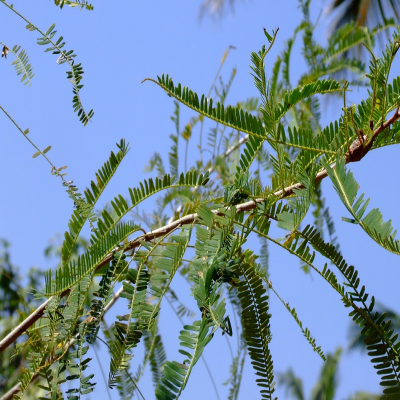Phyllanthus emblica L.
Synonyms : Emblica officinalis Gaertn.
Family : Phyllanthaceae
Group : 6. Star trees, Antidiabetic, Rejuvenatives, Eye diseases, Diuretic/renal protectant, Anti-dandruff/Hair growth promoters
Parts Used : Root , Fruit , Leaf , Bark
Vernacular Names :-
| English | : | Indian Gooseberry |
| Malayalam | : | Nelli |
| Hindi | : | Amla |
| Sanskrit | : | Amalaka |
| Kannada | : | Amla |
| Tamil | : | Nelli |
Distribution and Habitat: Found through out tropical and subtropical India, Sri Lanka and Malaca. It is abundant in deciduous forests of Madhya Pradesh and Darjeeling, Sikkim and Kashmir. It is also widely cultivated in India.
Botany: Small to medium sized deciduous tree growing up to 18 m in height with thin light grey bark exfoliating in small thin irregular flakes.
- Leaves: Simple, many subsessile, closely set along the branchlets, distichous light green having the appearance of pinnate leaves.
- Flowers: Greenish yellow in axillary fascicles, unisexual; males numerous on short slender pedicels; females few, subsessile; ovary 3-celled.
- Fruits: Globose, fleshy, pale yellow with 6 obscure vertical furrows enclosing 6 trigonous seeds in 2-seeded 3 crustaceous cocci. Two forms of amla are generally distinguished; the wild ones with smaller fruits and the cultivated ones with larger fruits and the latter are called ‘Banarasi’.
Properties: Antiviral. The fruit is diuretic, laxative, carminative, stomachic, astringent, anti-diarrhoeal, anti-haemorrhagic and anti-anaemic.
Chemical constituents:
- Amla fruit is a rich natural source of vitamin C (750-800 mg/100 g) pulp. It also contains cytokinin-like substances identified as zeatin, zeatin riboside and zeatin nucleotide.
- The seeds yield 16% fixed oil, brownish yellow in colour.
- The plant contains tannins like glucogallia, corilagin, chebulagic acid and 3, 6-digalloyl glucose. Root yields ellagic acid, lupeol, quercetin and β- sitosterol.
Uses:
- The fruit is useful in haemorrhage, leucorrhaea, menorrhagia, diarrhoea and dysentery. It goes in combination in the preparation of triphala, arishta, rasayan, churna and chyavanaprash. Sanjivani pills made with other ingredients are used in typhoid, snake-bite and cholera.
- The green fruits are made into pickles and preserves to stimulate appetite. It is effective as a nutritive tonic in general weakness. The dried fruits have good effect on hair hygiene and used as ingredient in shampoo and hair oil.
- Seed is used in asthma, bronchitis and biliousness.
- Leaves are also useful in conjunctivitis, inflammation, dyspepsia and dysentery. The bark is useful in gonorrhoea, jaundice, diarrhoea and myalgia.
- The root bark is astringent and is useful in ulcerative stomatitis and gastrohelcosis. Liquor fermented from fruit is good for indigestion, anaemia, jaundice, heart complaints, cold to the nose and for promoting urination.
Formulations: Triphala churnam
Agro technology
Soil and climate: Gooseberry is quite hardy and it prefers a warm dry climate. It needs good sunlight and rainfall. It can be grown in almost all types of soils, except very sandy type.
Propagation:
- Usually propagated by seeds and rarely by root suckers. Modified ring, patch and shield budding as well as soft wood grafting is now extensively practiced.
- The seeds are enclosed in a hard seed coat, which renders the germination difficult. The seeds can be extracted by keeping fully ripe fruits in the sun for 2-3 days till they split open releasing the seeds. Seeds are soaked in water for 3-4 hours and sown on previously prepared seedbeds and irrigated. Excess irrigation and water logging are harmful. One-month-old seedlings can be transplanted to polythene bags and one year old seedlings can be planted in the main field with the onset of monsoon. Pits of size 50 cm3 are dug at 6-8 m spacing and filled with a mixture of top soil and well rotten FYM and planting is done. Amla can also be planted as a wind- break around an orchard.
Varieties: Banarasi, Chakaiya, Francis, Kanchan, Krishna, Balwat, NA-6, NA-7, NA-9, Anand-2, BS-1
Manuring: 1kg N, 0.5 kg P2O5 and 0.75 kg K2O per plant/ year. The fertilizer should be given in two split doses, viz. April-May & Sept-Oct.
Irrigation: Irrigation should be given to young plants at 10 days interval during summer. To fruit bearing plantation, first irrigation should be given just at the time of fertiliser application and then at 15 days interval after fruit set (April) till onset on monsoon. Avoid irrigation during flowering period.
Plant protection:
- Rust disease caused by Ravellenia emblica appears during July to September. This disease can be controlled by spraying 0.2% Zineb.
- Fruit rot caused by Pencillium islandium can be managed by treating the fruits with sodium chloride.
- If the fruits show necrosis due to boron deficiency, spray borax at 0.05-0.06%.
- To control bark eating caterpillar (Indarbela tetraonis), inject kerosene oil or Dichlorvos or Endosulphan at 0.05%.
- The shoot gall maker (Betousa stylophora) is controlled by pruning gall twigs and spraying with 0.05% monocrotophos.
- During the rainy season, aphids (Cerciaphis emblica), scale insects and anar butterfly (Virachola isocrates) are the other common pests.
Harvesting: Planted seedlings will commence bearing from the 10th year, while grafts after 3-4 years. The vegetative growth of the tree continues from April to July. Along with the new growth in the spring, flowering also commences. Fruits will mature by December-February but vary substantially with varieties. Fruit yield ranges from 30-50kg/tree/year when full grown. Small sized fruits are used for making ayurvedic medicines. The fruits can be stored up to 15-20 days at low temp, but can be preserved for longer periods in 10-15% salt solution.



